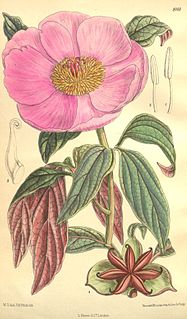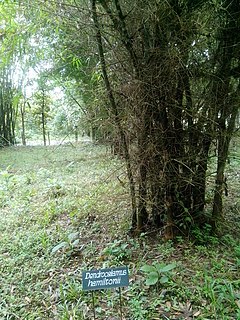Gaoligongshania megalothyrsa is a species of small, bushy mountain bamboo, in the monotypic genus Gaoligongshania. Like Ferrocalamus, this genus is found only in Yunnan Province of China, and near the Myanmar border, at an altitude of 1,600 to 2,200 m. It is named after the Gaoligong Mountains, where it is endemic.

Phyllostachys aureosulcata, the yellow groove bamboo, is a species of bamboo native to the Zhejiang Province of China. It is a running bamboo with a distinctive yellow stripe in the culm groove that is often grown as an ornamental.

Bambusa vulgaris, common bamboo, is an open-clump type bamboo species. It is native to Indochina and to the province of Yunnan in southern China, but it has been widely cultivated in many other places and has become naturalized in several regions. Among bamboo species, it is one of the largest and most easily recognized.
Arundinaria appalachiana, commonly known as hill cane, is a woody bamboo native to the Appalachian Mountains in the southeastern United States. The plant was elevated to the species level in 2006 based on new morphological and genetic information and was previously treated as a variety of Arundinaria tecta. As a relatively small member of its genus, it usually only attains heights of 0.5 to 1.0 metre with an either dense or diffuse habit. It is one of only three temperate species of bamboo native to North America. Hill cane is common on dry to mesic sites on upland slopes, bluffs and ridges in oak-hickory forests. In contrast to its sympatric relatives, Arundinaria gigantea typically appears along perennial streams, while A. tecta is found in swamps and other very wet areas.

Bambusa tulda, or Indian timber bamboo, is considered to be one of the most useful of bamboo species. It is native to the Indian subcontinent, Indochina, Tibet, and Yunnan, and naturalized in Iraq, Puerto Rico, and parts of South America.

Bambusa lako, known as Timor black bamboo, is a large species of bamboo originating from the island of Timor; its black culms may reach 21 m (69 ft) in height. A 2000 molecular study places it as closely related to the similar Indonesian species Gigantochloa atroviolacea, from which it was separated in 1997; it may soon be placed in that genus. Bambusa lako can only be grown in climates that are mostly frost free.

Dendrocalamus strictus is a bamboo species belonging to the Dendrocalamus genus. The culms (stems) are often solid. Common names include male bamboo, solid bamboo, and Calcutta bamboo.

Paeonia cambessedesii is a perennial herbaceous species of peony about 45 cm high. It has pink flowers. The stems, major veins and undersides of the leaves remain purple red, while the upper surface of the leaves turns into a metallic bluish green when fully grown and its lower leaves consist of no more than nine leaflets or segments. This endemic of the Balearic Islands is now limited to parts of northeastern and northwestern Majorca. In English it is sometimes called Balearic peony or Majorcan peony.

Bambusa bambos, the giant thorny bamboo, Indian thorny bamboo, spiny bamboo, or thorny bamboo, is a species of clumping bamboo native to southern Asia. It is also naturalized in Seychelles, Central America, West Indies, Java, Malaysia, Maluku, and the Philippines.

Dendrocalamus asper, also known as giant bamboo, or dragon bamboo, is a giant tropical, dense-clumping species native to Southeast Asia. Due to its common occurrence across Asia and its attractive features as well as ease of harvesting, this species has been introduced widely across Latin America and Africa. It is a sympodial or clumping bamboo that does not show lateral growth and therefore has no invasive properties.

Dendrocalamus hamiltonii, or Hamilton's bamboo, is a species of bamboo, 12–15 cm in diameter and growing up to 15–18 m in height, found in South Asian countries such as, India, Sri Lanka, Bhutan, Nepal, Pakistan, and far eastern China.
Dendrocalamus giganteus, commonly known as giant bamboo, is a giant tropical and subtropical, dense-clumping species native to Southeast Asia. It is one of the largest bamboo species in the world.
Ochlandra stridula, the Ceylon reed-bamboo, reed bamboo or forest bamboo, is a species of bamboo in the grass family). It is endemic to Sri Lanka. It can be found extensively in Ratnapura and Kegalle districts, in waste lands of rainforest and also along stream banks and I in forest gaps.
Neololeba atra, the black bamboo, is a species of tropical Asian, Australian, and Papuasian genus of bamboos in the grass family.

Bambusa polymorpha, or Burmese bamboo, is a species of clumping bamboo native to Bangladesh, Laos, Myanmar, Thailand, Sri Lanka, Java, Cuba, Puerto Rico, and Ecuador.
Dendrocalamus longispathus, the long-sheath bamboo, is a bamboo species which grows up to 20 m tall. It is native to Bangladesh, Myanmar, and Thailand. It has now become an exotic species all over the South Asia.
Melocanna baccifera is one of two bamboo species belonging to the Melocanna genus. It grows up to 10–25 m tall. It is native to Bangladesh, Myanmar, India, and Thailand.

Thyrsostachys siamensis is one of two bamboo species belonging to the genus Thyrsostachys. It grows up to 7 to 13m tall. It is native to Yunnan, Myanmar, Laos, Thailand, Vietnam and naturalised in Sri Lanka, Bangladesh, Malaysia. The plant is also known as long-sheath bamboo, monastery bamboo, Thai bamboo, Thai umbrella bamboo, umbrella bamboo, and umbrella-handle bamboo.
Bambusa barpatharica is a species of Bambusa bamboo.

Festuca brachyphylla, the alpine fescue, is a grass native to Eurasia, North America, and the Arctic. The grass is used for erosion control and revegetation. The specific epithet brachyphylla means "short-leaved". The grass has a diploid number of 28, 42, or 44.












